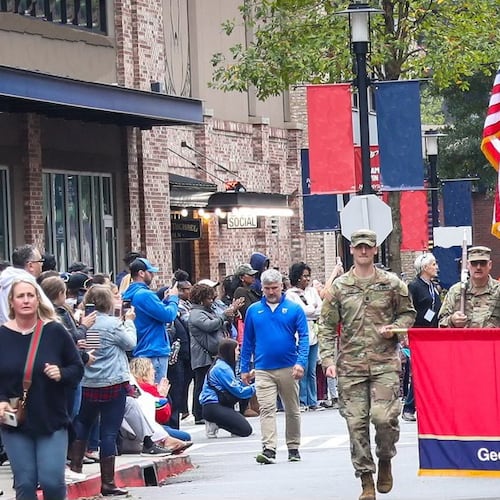What happens when all the skies have fallen and all the tragedies have been lived? What do we do next?
Such questions have permeated choreographer George Staib’s creative process for “Ararat,” the beginning. The ambitious multimedia work is set for three first-iteration performances at Emory University’s Schwartz Center for Performing Arts, Dance Studio, Jan. 26-28 in advance of a world premiere in late fall.
“Ararat” examines the stories, facts, implications and subsequent diaspora that followed the early 20th century Armenian Genocide — an event close to Staib, who is of Armenian-Iranian heritage.
Credit: Christina J. Massad
Credit: Christina J. Massad
Preparations were underway during a recent rehearsal in Emory’s Dance Studio theater, where a hanging sculpture spanned the room’s upper dimensions.
Torn strips of crinkled paper, in shades of ivory, beige, brown and black — future projection surfaces — were stuffed into a grid-like mesh strewn among suspended wooden frames of varying shapes.
About a half-dozen dancers walked in lines, sporadically clutching their hearts to the sound of arrows whizzing through the air. They spiraled to the floor in slow motion, as if in a clouded daze, then arrived balanced on the back of their pelvises, limbs floating upward as if in a state of innocence or indecision — a pause at an inflection point.
It’s part of a process filled with questions, many of which will be answered this weekend when several of “Ararat’s” collaborators bring their respective works together for the first time. After rehearsal, Staib, artistic director of staibdance, spoke with ArtsATL about his background and his creative process.
Q: Before we talk about the work itself and your process, tell us about your personal relationship to the Armenian genocide.
A: I feel other cultures and people are putting so much weight and sorrow on it. But with Armenians, there’s an austere kind of acceptance, even among my distant relatives from Armenia who have had people who were killed but are absorbing it as a matter of course.
My grandmother was born in India to an Armenian family and married an Armenian man. To escape the genocide, they went from Armenia to Isfahan in Iran. She endured so much, gradually having wealth and status taken from her. During the birth of her youngest daughter, they mis-injected the anesthesia and she became paralyzed from the waist down, but she could use a walker. Then the [Iranian] revolution happened, and their land and houses were taken away. So they came to the United States. Then she fell and broke her femur. It was not set properly, which put her in a wheelchair permanently.
She and my parents moved to Las Vegas and she started to experience kidney failure. Throughout the whole thing, she’s like, “Eh, this is what happens.” (Staib laughs) It was a doorway into the generalized Armenian mentality, a kind of resilience. She didn’t dwell on her situation. I think her joys were immediate and family-driven.
Q: What sparked the idea to delve into this subject creatively?
A: Because of the genocide, I have no physical ties with Armenia or Turkey. I started to think, wow, we [Armenians] are all over the [world], absorbing the culture of whatever is around us. It happened to fall in line with the pandemic when things shut down. The shutting down of a thing always means it’s going to restart differently. So the three parallel things [informing the work] are the genocide, the Great Flood, because Mount Ararat is where Noah’s Ark is fabled to be, and the starting again post-pandemic.
Q: Where does this first iteration fit into the work’s overall production process?
A: This is the most vulnerable part of it. It’s like a beta test. What sticks? What lands? How much more cohesive does it need to be, or how much more splintered is it going to be? Anything that suggests a narrative arc is something that we keep turning our back on.
Q: Why is that?
A: For me, the flurry of images speaks more than a beginning, middle and end. I don’t want to retell the story of the genocide. I don’t want to make assumptions about my own life or anybody else’s life. I want to [show] multiple trajectories -- some that succeeded, some that were abandoned.
Q: You’ve said that “Ararat” speaks to a collective understanding that “place” is an ethereal notion, stronger than land ownership or political control. How does that idea find its way into your process?
A: The idea is that the place keeps changing. [Through video projections] we are in a beautiful pasture. We are watching a forest burn down. We’re seeing the ocean, a mountain, a heartbeat.
Q: In what ways is “Ararat” different from your previous creations, such as “fence”?
A: I’ve often dealt with going into the thing, and then [experiencing] a breaking point. But I hadn’t thought about what happens after that, when there’s bewilderment and calm and the future is unfolding in front of you. When time slows down, and you finally get your bearings, and the baby is born, or the divorce happens, or you’ve relocated or you’ve lost the job? When reality sets in, and there’s a call to action, now what do you do?
Q: What do you want audiences to come away with?
A: I would love for them to be comfortable being uncomfortable, and to not necessarily figure out what I am trying to say but figure out how they are living inside of the work.
In conjunction with “Ararat, the beginning,” staibdance has partnered with ArtsATL.org to provide the following opportunities for community members to engage in facilitated conversations and workshops surrounding contemporary dance and art:
Build The Engine. Move, create and encounter some of the choreographic material that anchors staibdance’s work. Jan. 28, 10 a.m.-12 p.m. $10.
Move Your Story. Take a deep dive into the creative process by developing abstract scenarios with movement and text. Jan. 28, 3 p.m.–5 p.m. $10.
ArtsATL senior editor Gillian Anne Renault and Staib will host a post-show discussion immediately following the Friday and Saturday performances. All events will take place at Schwartz Center for Performing Arts, Dance Studio. Register for workshops at staibdance.com.
Credit: ArtsATL
Credit: ArtsATL
MEET OUR PARTNER
ArtsATL (www.artsatl.org), is a nonprofit organization that plays a critical role in educating and informing audiences about metro Atlanta’s arts and culture. Founded in 2009, ArtsATL’s goal is to help build a sustainable arts community contributing to the economic and cultural health of the city.
If you have any questions about this partnership or others, please contact Senior Manager of Partnerships Nicole Williams at nicole.williams@ajc.com.
About the Author
The Latest
Featured



